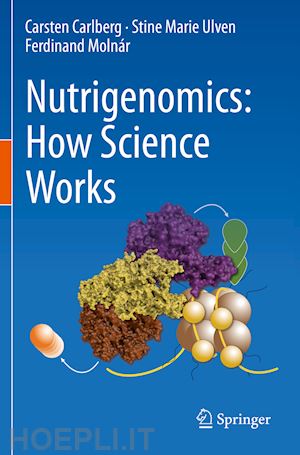

Questo prodotto usufruisce delle SPEDIZIONI GRATIS
selezionando l'opzione Corriere Veloce in fase di ordine.
Pagabile anche con Carta della cultura giovani e del merito, 18App Bonus Cultura e Carta del Docente
The fascinating area of Nutrigenomics describes this daily communication between our diet and our genome. This book describes how nutrition shapes human evolution and demonstrates its consequences for our susceptibility to diseases, such as diabetes and atherosclerosis. Inappropriate diet can yield stress for our cells, tissues and organs and then it is often associated with low-grade chronic inflammation. Overnutrition paired with physical inactivity leads to overweight and obesity and results in increased burden for a body that originally was adapted for a life in the savannahs of East Africa. Therefore, this textbook does not discuss a theoretical topic in science, but it talks about real life and our life-long “chat” with diet. We are all food consumers, thus each of us is concerned by the topic of this book and should be aware of its mechanisms.
Prof. Carsten Carlberg: Professor for biochemistry at the School of Medicine, Institute of Biomedicine at the University of Eastern Finland. The main research interests of Prof. Carlberg are (epi)genomics of nuclear receptors and their ligands with special focus on vitamin D. So far he published more than 190 papers (H-index 50). Since 2003 he is lecturing yearly the course "Nutrigenomics", which is the basis of this textbook. Together with Dr. Molnár he also published the Springer textbook "Mechanisms of gene regulation".
Prof. Stine Marie Ulven: Professor at the Department of Nutrition, Institute of Basic Medical Sciences at the University of Oslo (Norway). The main research interests of Prof. Ulven are human dietary intervention studies and diet-gene interactions with particular focus on the role of dietary fat in prevention of chronic diseases. She has in total published 43 papers (H-index of 18).
Prof. Ferdinand Molnár: Associate Professor of Biology at the School of Sciences and Humanities, Department of Biology at the Nazarbayev University, Kazakhstan. The main research interests of Prof. Molnár are integrative structural biology and bioinformatics, eukaryotic transcriptional regulation in health and disease, and recombinant protein production. He has published 30 papers (H-index 19) on the molecular structure of nuclear receptor proteins and their natural and synthetic ligands. Together with Prof. Carlberg he published Springer textbooks on "Mechanisms of gene regulation”, “Nutrigenomics” and “Epigenomics”.











Il sito utilizza cookie ed altri strumenti di tracciamento che raccolgono informazioni dal dispositivo dell’utente. Oltre ai cookie tecnici ed analitici aggregati, strettamente necessari per il funzionamento di questo sito web, previo consenso dell’utente possono essere installati cookie di profilazione e marketing e cookie dei social media. Cliccando su “Accetto tutti i cookie” saranno attivate tutte le categorie di cookie. Per accettare solo deterninate categorie di cookie, cliccare invece su “Impostazioni cookie”. Chiudendo il banner o continuando a navigare saranno installati solo cookie tecnici. Per maggiori dettagli, consultare la Cookie Policy.